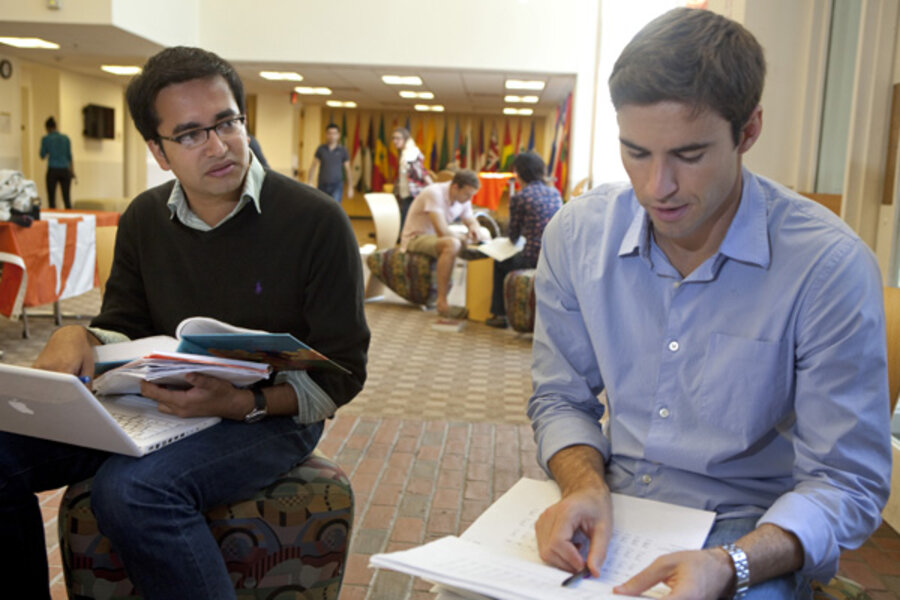Guide to top diplomacy programs
These are the top 15 international relations master's degree programs, according to the College of William & Mary's Teaching, Research, and International Policy (TRIP) project's 2011 survey of international relations faculty (IR) in 20 nations. The ranking is a tally of the top five programs supplied by respondents, which were then averaged.
1. Harvard University Kennedy School of Government (established 1936; www.hks.harvard.edu). Two Kennedy School professors, Joseph Nye and Stephen Walt, were ranked on two of the survey's lists of the best and most influential scholars in the field of international relations. Harvard has moved up from No. 3 last year.
2. Georgetown University Department of Government (est. 1922; government.georgetown.edu). Georgetown offers joint degrees in international relations and a master of science in foreign service through its Edmund A. Walsh School of Foreign Service. It was the first to confer a degree in "international affairs." Georgetown was ranked No. 8 last year.
3. Johns Hopkins University, The Paul H. Nitze School of Advanced International Studies (est. 1943; www.sais-jhu.edu). In addition to its Washington, D.C., campus, SAIS has locations in Bologna, Italy; and Nanjing, China.
4. Columbia University School of International and Public Affairs (est. 1946; sipa.columbia.edu). Nearly 38 percent of employed 2011 SIPA graduates are working in the private sector, 34 percent in the public sector, and 24 percent in nonprofits, with 6 percent pursuing further study.
5. Princeton University Woodrow Wilson School of Public & International Affairs (est. 1930; wws.princeton.edu). The class of 2011 alumni took their first jobs in the public sector (55 percent), the nonprofit sector (33 percent), and the private sector (12 percent).
6. London School of Economics Department of International Relations (est. 1927; www2.lse.ac.uk/internationalRelations). LSE director Sir William Beveridge felt the school, one of the oldest and largest IR programs, should "be equipped to deal with international affairs from all the three angles of law, history and administration."
7. Tufts University Fletcher School (est. 1933; fletcher.tufts.edu). The Fletcher School has admitted students from more than 40 countries.
8. George Washington University Elliott School of International Affairs (est. 1988; elliott.gwu.edu). The Elliott School is the largest school of international affairs in the United States.
9. University of Oxford Department of Politics and International Relations (est. 2000; www.politics.ox.ac.uk). It's home to The Centre for Political Ideologies and the Oxford Centre for the Study of Inequality and Democracy, among others. The program stresses an interdisciplinary approach.
10. American University School of International Service (est. 1958; american.edu/sis). The School of International Service was founded at the urging of President Dwight Eisenhower at the peak of the cold war.
11. Cambridge University Centre of International Studies (est. late 1970s; www.polis.cam.ac.uk/cis). The school has evolved from focusing on cold-war-era national security to globalization, opportunities for international collaboration, and leadership. It was No. 16 last year.
12. Stanford University Freeman Spogli Institute for International Studies (est. 1987; fsi.stanford.edu/centers). It conducts interdisciplinary educational programs and research. It was No. 15 last year.
13. Yale University Jackson Institute for Global Affairs (est. 2009; jackson.yale.edu). This is the newest IR program on the list. The institute's first class began its studies in the fall of 2010.
14. University of Chicago Committee on International Relations (est. 1928; cir.uchicago.edu). The Committee on International Relations is the oldest US program of its kind.
15. L'Institut d'etudes politiques (IEP) de Paris (est. 1871; http://www.sciencespo.fr/en). President François Hollande and the previous three presidents – Nicolas Sarkozy, Jacques Chirac, and François Mitterand – attended this school, known as Sciences Po, although Mr. Sarkozy dropped out. The school wasn't ranked last year.
•Sources: College of William & Mary; graduate schools' websites. For a complete list of top international relations programs, go to bit.ly/IRgradschools and scroll down to TRIP Around the World Survey, May 2012. The list is on page 62 of the PDF.






